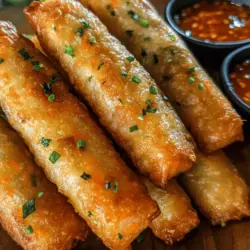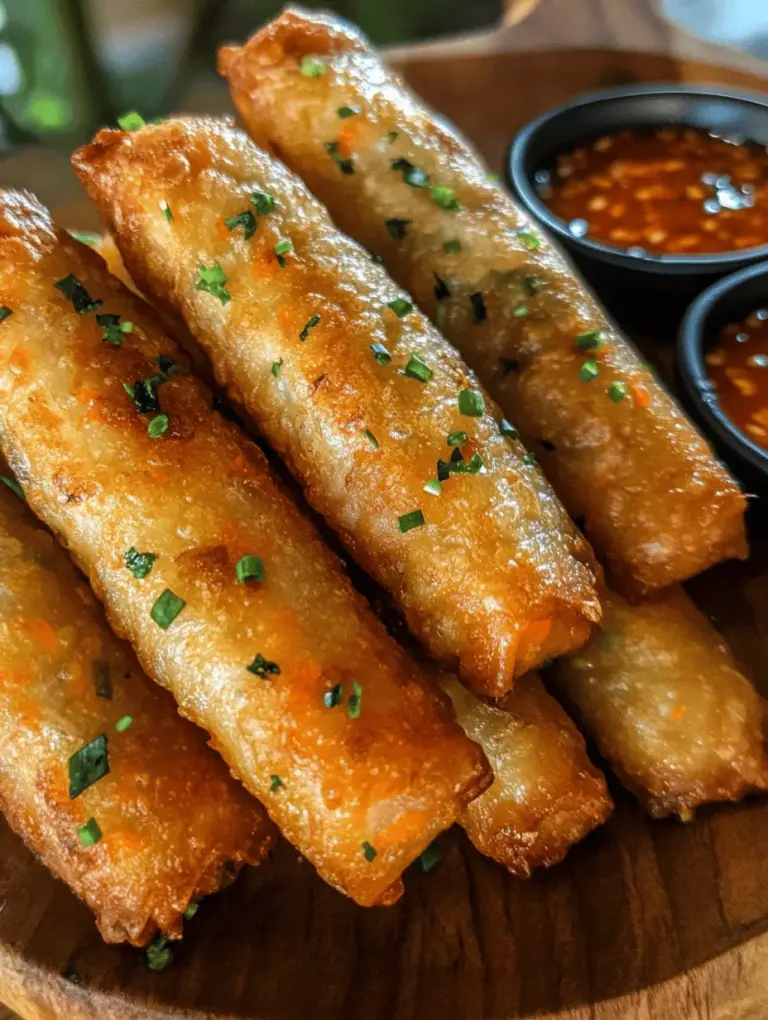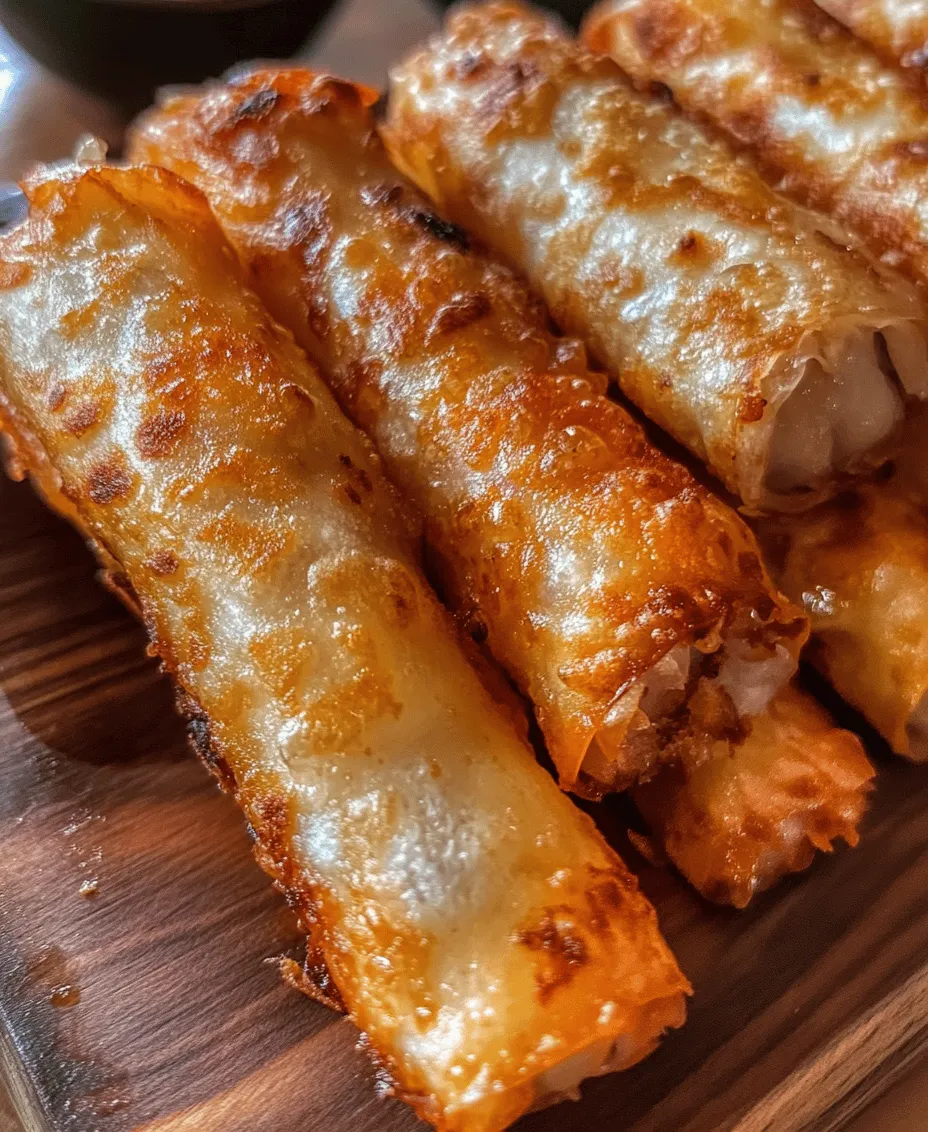Introduction
Lumpia, a beloved Filipino dish, has charmed its way into the hearts and stomachs of food lovers around the world. These delightful spring rolls are not just an appetizer; they are a cultural symbol, representing the warmth and hospitality of Filipino cuisine. When made right, Lumpia boasts a perfectly crispy exterior that gives way to a flavorful filling, making it irresistible to anyone who tries them.
In this article, we will delve into the exciting world of Golden Crispy Lumpia Rolls, exploring the essential ingredients, step-by-step instructions for preparation, tips to perfect this dish, and serving suggestions that will impress your guests. Whether you’re hosting a party, celebrating a special occasion, or simply craving a delicious snack, this recipe is sure to become a favorite in your kitchen.
Understanding Lumpia
Historical Context of Lumpia in Filipino Cuisine
The origins of Lumpia can be traced back to the Chinese spring rolls, which were introduced to the Philippines during the early Chinese migration to the archipelago. Over time, this dish evolved into a distinct staple of Filipino cuisine, adapting to local ingredients and culinary practices. Today, Lumpia is not only a popular street food but also a cherished dish served during family gatherings, festivals, and celebrations across the country.
Different Types of Lumpia
Lumpia can be categorized into two main types: fresh Lumpia and fried Lumpia. Fresh Lumpia, also known as “Lumpiang Sariwa,” features a soft, crepe-like wrapper filled with a mix of vegetables and protein, typically drizzled with a sweet peanut sauce. On the other hand, the fried version, which we will focus on in this recipe, is known for its crispy, golden-brown exterior and savory filling. Fried Lumpia is the quintessential party food, often served with a side of vinegar or sweet chili sauce for dipping.
Cultural Significance and Occasions for Serving Lumpia
In Filipino culture, food is an essential part of any gathering, and Lumpia holds a special place in the hearts of many. It is often served during celebrations such as birthdays, weddings, and holidays. The act of making Lumpia can also be a communal activity, bringing family and friends together in the kitchen to share stories and laughter while preparing this beloved dish. Each bite of Lumpia not only satisfies the palate but also evokes feelings of nostalgia, family, and connection to one’s roots.
Ingredients Breakdown
To achieve the perfect Golden Crispy Lumpia Rolls, it is crucial to understand the key ingredients that contribute to the dish’s flavor and texture.
Ground Pork: Flavor and Texture Contributions
Ground pork is the star ingredient in traditional Lumpia filling. It provides a rich, savory flavor and a satisfying texture that complements the other components. When cooked, the pork renders fat, which adds moisture to the filling, ensuring it remains juicy and tender. Using a combination of fatty and lean ground pork can enhance the overall taste and prevent the filling from becoming dry.
Vegetables: Nutritional Benefits and Flavor Enhancement
In addition to the meat, a variety of vegetables are typically included in the Lumpia filling. Common choices include carrots, cabbage, and green beans, which not only add vibrant color but also contribute essential nutrients and texture. Carrots bring sweetness and crunch, while cabbage provides a slight bitterness that balances the richness of the pork. Incorporating a mix of vegetables ensures a well-rounded flavor profile, making each bite delightful.
Sauces and Seasonings: Role in Achieving the Perfect Taste
To elevate the flavor of the filling, a blend of sauces and seasonings is essential. Soy sauce adds umami, while oyster sauce enhances the overall richness. Garlic, onions, and pepper not only add depth to the filling but also contribute aromatic qualities that tantalize the taste buds. A dash of sesame oil can be added for a nutty aroma, further enhancing the complexity of the flavors.
Importance of Using Fresh Ingredients for the Best Results
When it comes to making Lumpia, using fresh, high-quality ingredients is paramount. Fresh vegetables maintain their crunch and nutrients, while high-quality ground pork ensures the filling is flavorful and succulent. Avoid pre-packaged, frozen ingredients, as they can compromise the taste and texture of your Lumpia. Taking the time to source fresh produce not only improves the dish but also honors the tradition and care that goes into making this iconic Filipino food.
Preparing the Filling
Creating the filling for your Lumpia is a straightforward process that sets the foundation for a delicious outcome. Follow these steps for a perfectly balanced filling:
1. Sauté Aromatics: Begin by heating a tablespoon of oil in a large skillet over medium heat. Add finely chopped onions and minced garlic, sautéing them until they become fragrant and translucent. This step is crucial as it builds the flavor base of your filling.
2. Cook the Pork: Increase the heat to medium-high and add the ground pork to the skillet. Cook the pork until it is no longer pink, breaking it up with a spatula as it cooks. Ensure that it is evenly browned for the best flavor.
3. Add Vegetables: Once the pork is cooked, add your chosen vegetables. Diced carrots and shredded cabbage are popular choices. Stir-fry the mixture for about 5-7 minutes, allowing the vegetables to soften but still retain some crunch.
4. Season the Mixture: Pour in soy sauce and oyster sauce, stirring to combine. Season with salt and pepper to taste. Continue cooking for another 2-3 minutes, allowing the flavors to meld together.
5. Cool the Filling: After removing the skillet from heat, let the filling cool down. This is an important step, as wrapping the Lumpia with hot filling can cause the wrappers to tear.
Importance of Mixing Techniques for Flavor Distribution
To ensure a harmonious blend of flavors, it is essential to mix the ingredients thoroughly while cooking. This allows the sauces to coat the meat and vegetables evenly, ensuring that every bite is bursting with flavor. Avoid overcooking the vegetables; they should retain some crispness for the perfect bite experience.
Tips for Achieving the Right Consistency and Taste
– Taste as You Go: Always taste the filling as you season it. This will allow you to adjust the saltiness and flavor to your preference.
– Texture Matters: Aim for a filling that is moist but not watery. If there is excess liquid, allow it to evaporate during cooking.
– Customize: Feel free to experiment with additional ingredients, such as bell peppers, mushrooms, or even shrimp, to create your unique filling.
Alternative Filling Options for Dietary Preferences
For those with dietary restrictions or preferences, Lumpia can be easily customized. Here are some alternatives:
– Vegetarian Lumpia: Substitute the ground pork with a mixture of sautéed mushrooms, tofu, and a variety of vegetables for a delicious plant-based option.
– Chicken Lumpia: Use ground chicken instead of pork for a lighter version. The preparation process remains the same.
– Vegan Option: Replace all animal products with plant-based alternatives, ensuring to use vegan sauces and wraps.
Wrapping the Lumpia
Once your filling is prepared and cooled, it’s time to wrap the Lumpia. The wrapping process is key to achieving that coveted crispy texture and ensuring the filling stays intact during frying. Follow these detailed instructions to wrap your Lumpia effectively:
1. Gather Your Materials: You will need Lumpia wrappers, your cooled filling, and a small bowl of water (to seal the wrappers). It’s best to work with one wrapper at a time to keep them from drying out.
2. Position the Wrapper: Place a Lumpia wrapper on a clean, flat surface, with one of the corners facing you (like a diamond shape).
3. Add the Filling: Spoon about 2 tablespoons of the filling onto the lower third of the wrapper, leaving a bit of space around the edges for folding.
4. Start Folding: Begin by folding the bottom corner over the filling, tucking it in tightly. Then, fold in the side corners towards the center, creating a neat package.
5. Roll It Up: Continue rolling the wrapper away from you, keeping it snug as you go. Dip your fingers into the bowl of water and moisten the top corner of the wrapper before sealing it shut. This helps to secure the Lumpia and prevent it from opening during frying.
6. Repeat: Continue this process until all the filling is wrapped. Lay the finished Lumpia rolls on a baking sheet or plate, seam side down, to keep them secure while you prepare for frying.
Wrapping Lumpia may take a bit of practice, but with each roll, you will gain confidence and improve your technique. The effort invested in wrapping will pay off when you bite into those perfectly crispy rolls, revealing a burst of flavorful filling inside.
By following these steps and guidelines, you’ll be well on your way to mastering the art of making Golden Crispy Lumpia Rolls. In the next part of this article, we will cover the frying process, tips for achieving the ideal crispiness, and serving suggestions that will elevate your Lumpia experience to new heights. Stay tuned for more delicious insights!
Visual Cues to Ensure Proper Sealing
Sealing your Lumpia rolls correctly is crucial to prevent the filling from leaking during frying. When wrapping, look for these visual cues to ensure a tight seal:
1. Moisture: Slightly dampen the edges of the wrapper with water before folding. This helps create a sticky surface that holds the edges together.
2. Tuck and Roll: After placing the filling on the wrapper, fold the bottom edge over the filling, ensuring it’s snug but not overly tight. Tuck in the sides to create a neat package before rolling it up. The final edge should be sealed well with that dampened surface.
3. No Gaps: Inspect the edges of the roll. A well-sealed Lumpia should have no visible gaps. If you see any, press them together firmly before moving on to the next roll.
Common Mistakes to Avoid During Wrapping
To achieve perfectly wrapped Lumpia, be mindful of these common mistakes:
– Overfilling: It can be tempting to add more filling, but this can cause the wrappers to burst during frying. Stick to the recommended amount for a secure wrap.
– Using Dry Wrappers: If your wrappers are too dry, they can crack and tear. Keep them covered with a damp cloth while you work to ensure they remain pliable.
– Rushing the Process: Take your time when wrapping. A rushed job can lead to poorly sealed rolls that may open up in the oil.
Tips for Managing Wrappers to Prevent Drying Out
To keep your wrappers fresh and flexible, follow these tips:
– Cover with a Damp Cloth: As you wrap, keep the unused wrappers covered with a damp cloth to maintain their moisture.
– Work in Batches: Only take out a few wrappers at a time. This limits exposure to air and helps retain their softness.
– Store in an Airtight Container: If you’re not using the wrappers immediately, store them in an airtight container or resealable bag to prevent them from drying out.
Frying Techniques
Frying is the key step that brings your Lumpia to life, transforming them into deliciously crispy rolls. Understanding the frying process will help you achieve that golden-brown perfection.
Importance of Oil Temperature in Achieving Crispy Lumpia
The temperature of the oil significantly impacts the texture of your Lumpia. If the oil is too cool, the rolls will absorb excess oil, resulting in a soggy texture. Conversely, if the oil is too hot, the wrappers may burn before the filling is cooked.
Step-by-Step Guide on Frying the Rolls
1. Prepare the Oil: In a deep skillet or frying pan, pour in enough oil to fully submerge the Lumpia. Generally, 2-3 inches of oil is sufficient. Heat over medium-high heat.
2. Check the Temperature: Use a thermometer to monitor the oil temperature, aiming for around 350°F (175°C). If you don’t have a thermometer, you can test the oil readiness by dropping in a small piece of bread. If it sizzles and turns golden brown within 30 seconds, the oil is ready.
3. Fry in Batches: Carefully add the Lumpia rolls to the hot oil, ensuring not to overcrowd the pan. This allows the rolls to fry evenly and become crispy. Fry in batches, usually 4-6 rolls at a time, depending on the size of your frying pan.
4. Fry Until Golden: Cook the Lumpia for about 3-4 minutes on each side or until they turn golden brown. Use a slotted spoon to turn them occasionally for even cooking.
5. Drain Excess Oil: Once cooked, remove the Lumpia from the oil and place them on a plate lined with paper towels. This will absorb any excess oil.
How to Test Oil Readiness
As mentioned, you can use the bread test, but here are a couple more methods:
– Wooden Spoon Test: Dip the end of a wooden spoon into the oil. If bubbles form around the wood, the oil is hot enough.
– Water Drop Test: Carefully drop a small amount of water into the oil. If it sizzles and pops, your oil is ready to fry.
Managing Batches for Optimal Frying
Frying in batches is essential for achieving crispy results. Here’s how to manage it effectively:
– Maintain Heat: Keep an eye on the oil temperature. If it drops too low after adding the Lumpia, raise the heat slightly to maintain the ideal frying temperature.
– Fry One Batch at a Time: This ensures that each roll gets the attention it deserves, resulting in evenly cooked, crispy Lumpia.
Safety Tips for Frying at Home
Frying can be hazardous if proper precautions aren’t taken. Here are some safety tips to keep in mind:
– Avoid Water on Hot Oil: Water and hot oil don’t mix. Ensure your hands and the kitchen area are dry when working with hot oil.
– Use a Deep Fryer or Skillet with High Sides: This minimizes the risk of hot oil splashing out and burning you.
– Have a Lid Nearby: In case of a grease fire, never use water. Instead, cover the pan with a lid to smother the flames.
Serving Suggestions
Once your Golden Crispy Lumpia Rolls are ready, it’s time to think about how to serve them!
Ideas for Dipping Sauces that Complement Lumpia
Lumpia is best enjoyed with a variety of dipping sauces that enhance their flavor. Here are some recommended options:
– Sweet Chili Sauce: This is a classic pairing that offers a sweet and slightly spicy flavor, making it a perfect complement to the savory filling.
– Garlic Vinegar: A simple mix of vinegar, minced garlic, and a touch of sugar can create a tangy and refreshing dip.
– Peanut Sauce: For a richer flavor, serve Lumpia with a creamy peanut sauce that adds depth and creaminess.
Other Regional Sauces to Try
Explore different flavors by trying these regional sauces:
– Soy Sauce with Lemon: A simple blend of soy sauce and a splash of lemon juice can add a zesty tingle.
– Sriracha or Hot Sauce: For those who enjoy heat, a drizzle of Sriracha or your favorite hot sauce can elevate the experience.
Presentation Tips for Serving Lumpia at Gatherings
When serving Lumpia at gatherings, presentation matters. Here are a few tips:
– Arrange in a Fan Shape: Stack the Lumpia in a fan shape on a platter for an eye-catching display.
– Garnish with Fresh Herbs: Add fresh cilantro or parsley around the edges to enhance visual appeal.
– Serve with Colorful Dips: Present the sauces in small bowls alongside the Lumpia, creating a vibrant and inviting spread.
Nutritional Information
Understanding the nutritional content of Lumpia can help you enjoy this dish mindfully.
Overview of the Nutritional Content of Lumpia per Serving
On average, one serving of Lumpia (3-4 rolls) contains approximately:
– Calories: 250-300
– Protein: 8-10 grams
– Fat: 15-20 grams
– Carbohydrates: 30-35 grams
– Fiber: 2-3 grams
The actual nutritional content can vary based on the filling and frying method used.
Discussion on Balancing Indulgence with Healthier Choices
While Lumpia is a delightful treat, balancing indulgence with healthier choices is essential. Consider using lean protein, adding vegetables, or opting for baked Lumpia for a lighter version.
Suggestions for Side Dishes That Pair Well with Lumpia
To create a well-rounded meal, consider serving Lumpia with these side dishes:
– Asian Slaw: A refreshing slaw made with cabbage, carrots, and a light sesame dressing.
– Rice or Noodles: Serve with jasmine rice or stir-fried noodles to complement the flavors of the filling.
– Fresh Spring Rolls: For a lighter option, serve fresh spring rolls filled with vegetables and herbs.
Conclusion
Making Golden Crispy Lumpia Rolls at home is not just about cooking; it’s an experience that brings joy and satisfaction. The crunchy texture and savory filling come together to create a delightful culinary treat that is perfect for gatherings or quiet nights at home.
Encourage your friends and family to join you in this cooking adventure. Share the recipe, and let them experience the joy of creating these delicious rolls. The cultural significance and deliciousness of Lumpia reflect a rich heritage and love for food that transcends generations.
As you embark on your Lumpia-making journey, remember that each roll tells a story, whether it’s a family tradition or a new twist on an old favorite. Enjoy every bite and savor the moments spent in the kitchen!



